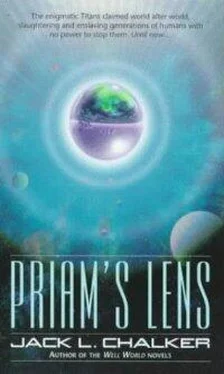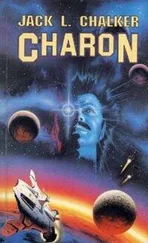Jack Chalker - Priam's Lens
Здесь есть возможность читать онлайн «Jack Chalker - Priam's Lens» весь текст электронной книги совершенно бесплатно (целиком полную версию без сокращений). В некоторых случаях можно слушать аудио, скачать через торрент в формате fb2 и присутствует краткое содержание. Год выпуска: 1999, ISBN: 1999, Издательство: Del Rey / Ballantine, Жанр: Фантастика и фэнтези, на английском языке. Описание произведения, (предисловие) а так же отзывы посетителей доступны на портале библиотеки ЛибКат.
- Название:Priam's Lens
- Автор:
- Издательство:Del Rey / Ballantine
- Жанр:
- Год:1999
- ISBN:0-345-40294-4
- Рейтинг книги:3 / 5. Голосов: 1
-
Избранное:Добавить в избранное
- Отзывы:
-
Ваша оценка:
- 60
- 1
- 2
- 3
- 4
- 5
Priam's Lens: краткое содержание, описание и аннотация
Предлагаем к чтению аннотацию, описание, краткое содержание или предисловие (зависит от того, что написал сам автор книги «Priam's Lens»). Если вы не нашли необходимую информацию о книге — напишите в комментариях, мы постараемся отыскать её.
Priam's Lens — читать онлайн бесплатно полную книгу (весь текст) целиком
Ниже представлен текст книги, разбитый по страницам. Система сохранения места последней прочитанной страницы, позволяет с удобством читать онлайн бесплатно книгу «Priam's Lens», без необходимости каждый раз заново искать на чём Вы остановились. Поставьте закладку, и сможете в любой момент перейти на страницу, на которой закончили чтение.
Интервал:
Закладка:
Harker looked around. “Okay, so where is this thing? And what the hell is it?”
Krill looked around, then pointed. “Over there. Through that tunnel.”
They walked quickly over and through, Krill leading the way, only to emerge in a much smaller chamber almost too cramped to fit them in their suits.
It was certainly a control room of some sort. A series of screens were mounted in front of a central console, the screens creating a 180-degree forward view and rising up almost to the ceiling. The console itself was not nearly as elaborate. There were no gauges, small screens, dials, switches, or anything of the sort. There was a single command chair, but it was oddly shaped and hardly designed for normal human sitting. It was, in fact, quite large and bulky.
“The command chair is designed to interface with a specially designed suit,” Krill noted, examining it thoroughly. “I’d say the whole thing was designed to connect a human in a suit designed for control purposes with the computer net integrated into the room. The screens appear to be for the observers’ benefit. This is most certainly it, though. The control center for Project Ulysses.”
“All right,” Harker responded. “So what the hell is it?”
“A control center, Mister Harker,” Juanita Krill replied. “A control center and aiming mechanism and a lot more for controlling a force nobody yet understands. Synchronize your suits for an incoming visual and I will transmit to you just what this is all about. I believe it is time that you know what the rest of us know, and perhaps I can also, at this point, fill in a few holes for the others.”
The synchronization took barely a moment, and then they all received an image of a vast starfield. Nothing in it looked familiar, although it appeared to cover a fair segment of space. What was telling was a bright and indistinct area shaped much like a giant eye that had to be an artifact of transmission; it couldn’t possibly be present in real life. It showed some stars and other structures, some clear, some a bit smudged as if obscured by gases, but what was important was that it did not match the surrounding starfield. It was like an eerie, eye-shaped window that looked right through the universe to another, different scene beyond. Even more strange, the eye would occasionally “blink”; it didn’t actually open and close, but the scene it revealed would shift radically, then, a bit later, shift back. It was pretty unnerving.
“That is Priam’s Lens,” Krill told them. “It is only a few parsecs from here, and it is what is known as a micro-lens. We’ve seen these since we could look into space with adequate equipment, but most tend to be of galactic or even supergalactic size. Walls and giant lenses and bubbling voids. This one is quite small. Smaller than an average gas giant, in fact. It is, of course, not real. It’s a distortion caused by something else that is there. Something so powerful and so mysterious that to call it an artifact of a singularity would be like calling an amputation a hangnail. We may never actually know what it is, because it isn’t at the Lens but instead causes it from some other place connected to this sector by this hole in space-time. We have seen many natural wormholes before, although they usually close rather quickly after they open. Judging from its gravitational effects, this one has been around a very long time and shows no signs of shutting down. In fact, controlling or at least capping it was the primary problem to be solved.”
“They capped a natural wormhole?” Harker was astonished.
“Well, yes and no. We could not cap the Lens—it does not help to cap what you cannot even know is there—but the mere existence of the Lens causes other, rather small and limited, wormholes to form all about it. Those were the ones that they sought to cap, and, in one or two cases, they apparently did. Its properties, as I said, are unique in our experience. There were many theories about what was on the other end of the Lens that might be causing the effects, but nothing could survive getting there or being in its presence. For computational purposes, it was termed Olympus, but what it is will remain a mystery until we encounter it or one like it. There are several theories on what it might be, but each is so unique in itself that it stretches credibility.”
“Such as?” van der Voort pressed.
“Whatever it is, it masks itself, and the energy it puts out is enormous. We’ve never found a way to properly measure it. It spawns artifacts and shoots them out and around in all directions, which is also a characteristic of a black hole, only it no longer appears to be swallowing anything. The area of space-time around it is so unstable that these natural wormholes have formed. Somehow they are as stable as the ones we create, but hardly passive.”
“Those smudges of instability around the lens—they are thick cosmic vortexes yet they are whipping and transforming around it like lightning,” van der Voort commented. “Fascinating.”
“Those are our natural wormholes, or perhaps they’re the wormhole at different points in space-time. Nobody is really certain,” Doctor Takamura explained. “My mentor, Natori Yamaguchi, spent his entire life and career trying to explain and analyze this instability. To tell you even what he and his colleagues believed would take too long and require that most of you go back for your doctorates in astrophysics, particle physics, and perhaps cosmology. In simple terms, though, he believed that what you are looking at might well be caused by a peculiar structure never before observed but long known to exist called a boltzmon. It is a black hole reduced to the point where it cannot exist anymore. Most of them open up holes in space-time and are believed to simply fall through. The Lens is but an artifact of that collapse, which may well be in some distant galaxy.”
“Where does this—boltzmon—fall through?” Harker asked.
“Nobody knows. Another universe, perhaps, or other dimensions. This one, however, so we infer from the surrounding matter, seems to have gotten itself stuck in a loop or bubble in space-time. It keeps falling into the hole, but it appears to not quite make it before time curves back so it keeps falling again, and so on. That is why the `eye,’ so to speak, appears to shift, or blink, in two stages. At least, that is the prevailing theory. This temporal loop is the cause of the microlens, and is also causing other previously unobserved phenomena, such as the generation of the wormhole or wormholes, and the spewing out of particle strings. Strings we’ve encountered before, but not like these. For one thing, they seem to be attracted to and go right up the center of the wormholes. They may be part of one and the same thing. In a better and more merciful universe, I and countless of my colleagues would be studying and measuring and experimenting and getting to understand this rather than theorizing about it. All I can tell you right now for sure is that if we energized the cap we have on the wormhole in this region, a fingerlike string of particles the likes of which we’ve never seen before would shoot out at essentially the speed of light. Its properties are—bizarre, as is its parent.”
“I can guess,” Harker replied. “But it doesn’t tell me what this place does.”
“This place?” Juanita Krill took over once more. “This place is where specially shielded, specially reinforcing gates can be turned on and off. That was, at least, the theory when it was built, but it’s never been fully operational and we are dealing with a phenomenon without precedent. For a century theoreticians have run models trying to explain and understand it, and I’ve given you a very simplified version of some of the more popular theories, but the important thing is, nobody knows. That’s because the only way to get to the Lens artifact is from areas now deep within Titan-occupied space. We can’t measure it and we can’t play with it. The money involved in just getting this far was cut from The Confederacy budget in the early fights over how best to meet the Titan threat. Much of it went into conventional weaponry that could be more quickly and cheaply built and deployed—or on worlds of influential politicians. They couldn’t afford research on an idea that might be no more than a scientific curiosity. Only the Karas family, which made its fortune building genhole plates and gates, saw its potential as a weapon. And as the futility of conventional arms and tactics was made clear, and the Titan advance clearly turned in this direction, and the direction of a dozen other worlds built as preserves by great industrial families or corporations, they decided to act on their own to try and save their worlds.”
Читать дальшеИнтервал:
Закладка:
Похожие книги на «Priam's Lens»
Представляем Вашему вниманию похожие книги на «Priam's Lens» списком для выбора. Мы отобрали схожую по названию и смыслу литературу в надежде предоставить читателям больше вариантов отыскать новые, интересные, ещё непрочитанные произведения.
Обсуждение, отзывы о книге «Priam's Lens» и просто собственные мнения читателей. Оставьте ваши комментарии, напишите, что Вы думаете о произведении, его смысле или главных героях. Укажите что конкретно понравилось, а что нет, и почему Вы так считаете.












